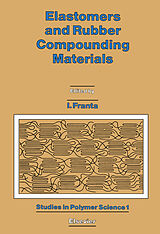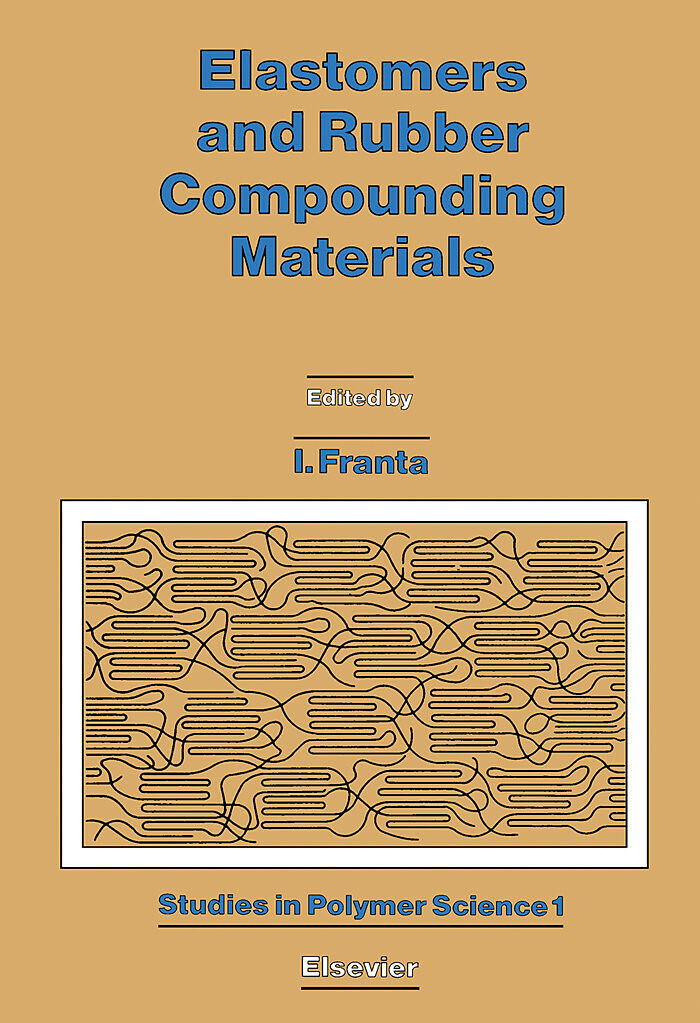Elastomers and Rubber Compounding Materials
Format:
E-Book (pdf)
EAN:
9780444601186
Genre:
Technik
Herausgeber:
Elsevier Science & Techn.
Anzahl Seiten:
607
Erscheinungsdatum:
02.12.2012
Elastomers and Rubber Compounding Materials reviews the properties of elastomers and particular groups of ingredients and chemicals mixed into the basic elastomer to form a rubber compound.
After introducing the history of rubber industry and the general properties of rubber, the book discusses the properties, classification, concentration, stabilization, modification, application, transport, and storage of latex. It presents as well the methods of production, composition, physical properties, and chemical reactions of dry rubber. The book then focuses on the production and classification of different synthetic rubbers, such as styrene-butadiene, isoprene, butadiene, ethylene-propylene, and chloroprene. It also discusses the production, properties, and applications of elastomers, vulcanization chemicals, fillers, stabilizers, plasticizers, blowing agents, and textile reinforcing materials used in formulating rubber compounds.
This book will be of great value not only to those who are in the rubber industry, but also to students of polymer science and rubber technology.
Inhalt
Preface
Chapter 1. Introductory Part
1.1 Brief history of rubber
1.2 Introduction and general description of rubbers
1.3 Some general properties of rubber
Chapter 2. Natural Rubber
2.1 Latex
2.1.1 Properties
2.1.2 Classification
2.1.3 Concentration
2.1.4 Stabilization (preservation)
2.1.5 Modification
2.1.6 Application
2.1.7 Transport and storage
2.2 Dry rubber
2.2.1 Older method of production
2.2.2 New method of production
2.2.3 Market grading of natural rubber
2.2.4 Technically classified rubber (TC rubber)
2.2.5 New specifications (Standard Malaysian Rubber - SMR)
2.2.6 Composition
2.2.7 Physical properties
2.2.8 Chemical reactions of natural rubber
Chapter 3. Synthetic Rubbers Production Methods
3.1 Survey of the development of synthetic rubbers
3.2 Classification of polymerization reactions
3.3 Polymerization of functional groups
3.4 Free radical chain addition polymerization
3.5 Emulsion polymerization
3.6 Copolymerization
3.7 Addition polymerization by cationic mechanism
3.8 Addition polymerization by anionic mechanism
3.9 Stereospecific polymerization with coordination catalysts
3.10 Graft and block copolymerization
Chapter 4. Synthetic Rubbers
4.1 Classification of rubbers according to their uses and properties
4.1.1 Rubbers for general and special purposes
4.1.2 Comparison of rubbers according to important properties
4.2 Styrene-butadiene rubber
4.2.1 Production
4.2.2 Commercial grades
4.2.3 The structure of styrene-butadiene rubber
4.2.4 Vulcanization
4.2.5 Properties of SBR compounds and vulcanizates
4.2.6 SBR applications
4.2.7 Styrene-butadiene copolymers with a higher content of styrene
4.2.8 Styrene-butadiene latices
4.3 Isoprene rubbers
4.3.1 Production
4.3.2 Commercial grades
4.3.3 Structure
4.3.4 Vulcanization
4.3.5 Properties of IR compounds and vulcanizates
4.3.6 IR applications
4.3.7 Polyisoprene latex
4.3.8 Isoprene copolymers
4.3.9 trans-1,4-Polyisoprene
4.4 Butadiene rubber
4.4.1 Historical development of butadiene rubber
4.4.2 Production of solution butadiene rubber
4.4.3 Structure and properties of butadiene polymers
4.4.4 Commercial grades
4.4.5 Vulcanization
4.4.6 Properties of BR vulcanizates
4.4.7 BR applications
4.4.8 trans-1,4-Polybutadiene
4.5 Ethylene-propylene rubber
4.5.1 Production
4.5.2 Structure and properties of the ethylene-propylene polymers
4.5.3 Commercial grades
4.5.4 EPM vulcanization
4.5.5 EPDM vulcanization
4.5.6 Compounding and properties of EPR vulcanizates
4.5.7 EPR applications
4.6 Chloroprene rubber
4.6.1 Production
4.6.2 Structure and properties
4.6.3 Vulcanization
4.6.4 Commercial grades and CR applications
4.6.5 Chloroprene latices
4.7 Acrylonitrile-butadiene rubber
4.7.1 Production
4.7.2 Commercial grades
4.7.3 Structure and properties of acrylonitrile-butadiene polymers
4.7.4 Vulcanization
4.7.5 NBR compounding
4.7.6 Properties of the NBR vulcanizates
4.7.7 NBR applications
4.7.8 Solutions
4.7.9 Carboxylated nitrile rubber
4.7.10 Latices
4.7.11 Liquid and powdered nitrile rubber
4.8 Butyl rubber, chlorobutyl rubber and bromobutyl rubber
4.8.1 Production
4.8.2 Commercial grades
4.8.3 Structure
4.8.4 Vulcanization
4.8.5 Properties of IIR
4.8.6 Butyl rubbers applications
4.8.7 Butyl rubber latex
4.9 Polyurethane rubbers
4.9.1 Production
4.9.2 Structure and properties
4.9.3 Polyurethane applications
4.10 Polysulphide rubbers
4.10.1 Production
4.10.2 Structure
4.10.3 Plasticization and vulcanization
4.10.4 Properties of polysulphide rubbers
4.10.5 Commercial grades
4.10.6 Polysulphide rubber applications
4.10.7 Latices
4.10.8 Liquid polymers
4.11 Chlorosulphonated and chlorinated polyethylene
4.11.1 Production of CSM
4.11.2 Structure of CSM
4.11.3 CSM vulcanization
4.11.4 Properties of CSM
4.11.5 Commercial grades and CSM applications
4.11.6 Production, structure and grades of CM
4.11.7 Compounding and properties of CM
4.12 Polyacrylate rubber
4.12.1 Production
4.12.2 Structure and commercial grades
4.12.3 ACM vulcanization
4.12.4 ACM compounding
4.12.5 Properties
4.12.6 ACM applications
4.13 Fluorocarbon rubbers
4.13.1 Production
4.13.2 Commercial types
4.13.3 The structure and properties of the fluorocarbon polymers
4.13.4 Vulcanization
4.13.5 FKM compounding
4.13.6 Properties of F KM vulcanizates
4.13.7 FKM applications
4.13.8 Fluorosilicone elastomers
4.14 Silicone rubbers
4.14.1 Structure and properties
4.14.2 Production
4.14.3 Vulcanization of silicone rubbers
4.14.4 Properties and applications
4.14.5 Commercial grades of silicone rubbers
4.15 Epichlorohydrin rubber
4.15.1 Production
4.15.2 Commercial grades
4.15.3 Vulcanization of Hydrin rubbers
4.15.4 Properties of Hydrin compounds and vulcanizates
4.15.5 Hydrin rubber applications
4.15.6 Polypropylene oxide rubber
4.16 Thermoplastic elastomers
4.16.1 Styrene-diene block copolymers
4.16.2 Styrene-olefin block copolymers
4.16.3 Thermoplastic polyurethanes
4.16.4 Copolyester ethers
4.16.5 Polyolefin thermoplastic copolymers
4.17 Ethylene-vinyl acetate rubber
4.18 Other rubbers
4.19 Liquid rubbers
Chapter 5. Reclaimed Rubber
5.1 The principle of the reclaiming process
5.1.1 Natural rubber
5.1.2 Styrene-butadiene rubber
5.2 Reclaiming additives
5.2.1 Reclaiming oils
5.2.2 Chemical reclaiming agents
5.2.3 Choice of reclaiming additives
5.3 Production of reclaimed rubber
5.3.1 Preparation of waste rubber for reclaiming
5.3.2 Reclaiming processes

Leider konnten wir für diesen Artikel keine Preise ermitteln ...
billigbuch.ch sucht jetzt für Sie die besten Angebote ...
Die aktuellen Verkaufspreise von 2 Onlineshops werden in Realtime abgefragt.
Sie können das gewünschte Produkt anschliessend direkt beim Anbieter Ihrer Wahl bestellen.
Loading...
Die aktuellen Verkaufspreise von 2 Onlineshops werden in Realtime abgefragt.
Sie können das gewünschte Produkt anschliessend direkt beim Anbieter Ihrer Wahl bestellen.
| # | Onlineshop | Preis CHF | Versand CHF | Total CHF | ||
|---|---|---|---|---|---|---|
| 1 | Seller | 0.00 | 0.00 | 0.00 |
